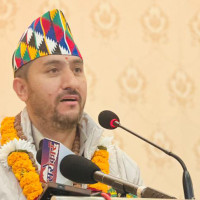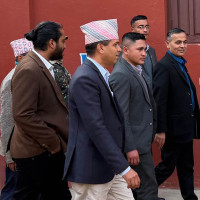- Sunday, 21 December 2025
Life expectancy at birth climbs to 71.3 years
Kathmandu, May 6: Nepal’s life expectancy at birth increased by five years in a decade (2011 to 2021) from 66.6 years to 71.3 years.
A booklet entitled ‘Demographic Indicators’, made public by the National Statistics Office (NSO) based on the data of Nepal National Census 2021 Sunday, showed that the life expectancy at birth had reached 71.3 years in 2021 from 66.6 years in 2011.
The NSO has published the booklet of ‘Demographic Indicators’ and Population Literacy with the statistics and reports of the Nepal National Census 2021.
The report shows that the average life expectancy of females is more than five years longer than the average life expectancy of males. The average life expectancy of men has reached 68.2 years and the average life expectancy of women has reached 73.8 years.
Presenting the indicators, Chief Statistician of NSO Arjun Prasad Pokharel said the increase in average life expectancy of Nepali reflects improvement in social and economic aspects.
“This is only an average statistic. There might be huge gaps between the life expectancy of people living in various geographic and their economic status. So, the statistic will be useful for the policy makers and government to carry out the development programmes, including health services, educational activities, among others, to minimise the gap of life expectancy” he said.
Deputy Chief Statistician of NSO Dr. Hem Raj Regmi said that more than 400 demographic indicators are published based on the Nepal National Census 2021.
The indicators included birth rate, death rate and migration, among others, up to the provincial levels which would be valuable for all stakeholders and policy makers, including federal and provincial government, to carry out the social and economic activities.
He said that the NSO would also make public other indicators based on the Census in coming days.
In the last 40 years, life expectancy of Nepali citizens has been added by almost by 22 years. The average life expectancy of people was 49.8 years in 1981. In that time, the average life expectancy of males was 48.1 years and the females 50.9 years.
Regmi said that increasing life expectancy of Nepali citizens by almost 22 years in 40 years is a great achievement.
Based on the provincial life expectancy, Karnali Province has the highest life expectancy of 72.5 years, followed by Bagmati of 72.4 years, Gandaki Province of 72.1 years and Madhes Province of 71.8 years.
Lumbini Province has the lowest life expectancy of 69.5 years. The life expectancy of Koshi Province is 70.4 years and Sudurpashchim Province of 71.3 years.
Annual population growth rate at 0.92%
The statistics showed that the annual growth rate of population is increasing at the rate of 0.92 per year in Nepal.
The report showed that the annual growth rate of the population is less than 1 per cent. This is the lowest in the 80-year history of Nepal.
Between 2011 and 2021, there was an increase of about 2.8 million population.
The highest growth rate of population is in Lumbini Province at 1.24 per cent, followed by Madhes Province at 1.19 per cent and Bagmati Province at 0.97 per cent.
Sudurpashchim has the lowest population growth rate at 0.52 per cent while the growth rate of population in Karnali Province is 0.70 per cent and Koshi Province is 0.86 per cent.
The statistics showed that there are 60.1 per cent single/nuclear families in Nepal while 39.1 per cent live in joint families.
The concept of joint family is more prevalent in Madhes Province. Single families are more common in Bagmati, while Bagmati is the last in the province where joint families live.
Improvement in infant mortality
The statistics showed that the infant mortality rate has improved significantly in four decades.
The infant mortality rate per 1,000 live births has dropped to 17 in 2021 from 40 in 2011. The infant mortality rate per 1,000 live births was 117 in 2081, 97 in 2091 and 64 in 2001.
The number of children who die in any one year per 1,000 children under the age of 1 to 5 years is the lowest in Gandaki Province and Sudurpashchim Province has the highest number of deaths.
In the case of Nepal, child mortality rate per 1,000 aged between 1-4 years is 6.1. The infant mortality rate was 12.9 per 1,000 in 2011 and 28.6 in 2001.
In this age group, there is some difference in the death rate between girls and boys in the Province. The death rate of sons as compared to daughters is higher in some provinces.
The mean age of child bearing is 27.44 years in Nepal.
The average age at which women between the ages of 15 and 49 give birth is 28.48 years in Bagmati Province. Similarly, mean age of child bearing is 27.64 years in Lumbini Province, 27.54 years in Koshi Province, 27.25 years in Gandaki Province, 27.08 years in Sudurpashchim Province, 27.03 years in Madhes Province and 26.90 years in Karnali Province.















-original-thumb.jpg)

